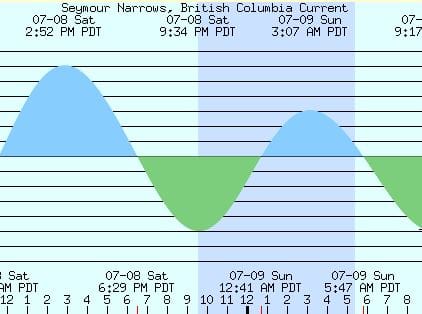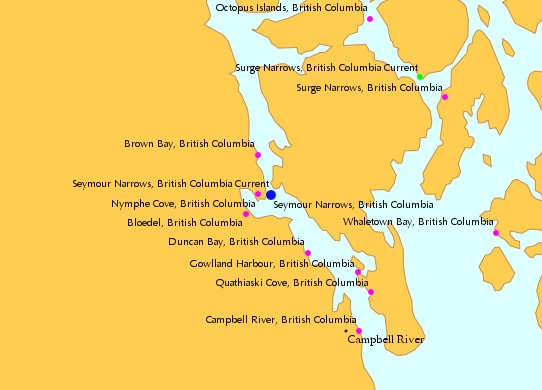Once you leave Ketchikan, the voyage to Vancouver is dictated by just one thing: the slack tide at Seymour Narrows. And as the time of slack tide (the moment the current goes from Ebbing to Flooding or vice versa) changes every day, the planning for this section of the cruise has to be reviewed for every passage. As the tides go up and down (and in and out) on a six hour cycle, the slack tide at the Narrows is moving to and from within a six hour cycle as well. On average that boundary is somewhere between 8 pm in the evening and 2 pm. in the morning. There are 3 more slack tides in the day but the evening one is the important one for us. Important because of the time needed to get from Seymour Narrows to Vancouver and after departure back again. At the minimum you need 5 hrs. as the distance between Vancouver / Lions gate Bridge and Cape Mudge (there where the approach to the Narrows start) is 96 miles and the normal top speed of a cruise ship is around 20 knots.
For today there was a slack tide at 18.29 hrs. when the flood went to ebbing and at 00.41 hrs. on Sunday morning when ebbing went to flood.

In this diagram each horizontal line indicates 2 knots of current. Thus the current on Saturday at 2.52 PM PDT came to 12 knots.
So the captain has to make a decision, which tide to take. 18.29 hrs. is very early and you have to race down the coast to get there on time and even then it is doubtful if you make it. So it makes sense to focus on 00.41 hrs. This does not mean that you have to go through there at that time. Normally the pilots are quite comfortable with anything under 4 knots.

Overview of the Seymour Narrows area. For us the approach starts near Brown Bay; then there is no place else to go anymore and it ends at Cape Mudge where we are back in open waters.
Thus the navigator sorts outs the times that work best for the schedule and then the captain decides on the window of opportunity. If you look at the diagram you can see that slack tide is at 12.41 am on Sunday 9th of July between there is a curve in the tide. Each line gives two knots of current speed and thus the first moment for the ship to go through would be 23.45 hrs. Saturday evening. So the captain sets his initial sights on this time. When the pilot’s board, there will be a Master Pilot discussion and a decision is made if this time is the best. Taking into consideration, the local knowledge of the pilots, the latest navigation information, expected traffic at the Narrows and along the road and anything else which might cause delays. Once a time has been decided upon the speed for that time is set and the route decided. Maybe there is time for some sightseeing but maybe the ship has to take the shortest route just to get there on time.
During the approach to the Narrows, the pilots receive constant updates in regards to traffic near the Narrows from a VTS system that we have here in the British Inside Passage. Also by now they will have heard from their colleagues what the other cruise ships want (normally we all want the same) and have thrashed out a schedule among themselves of who should go first through the hole as there is only room for one ship at the time. For “who goes first” that has mainly to do with who needs to arrive in Vancouver first and that is normally the ship that is assigned to Ballantyne Pier which is the 2nd cruise terminal in the port after Canada Place.
Once this is all sorted out, the cruise ships line up behind each other, normally 5 to 10 minutes apart, and they speed up and slow down then depending on any issues the first ship has with tug and tows or fishing boats which are also in the transit.
With a passage time of 23.45 hrs. the ship will then be in open waters again, passed Cape Mudge at 00.30 and that gives it then 6 hrs. to cover 96 miles to be under the Lions Gate bridge at 06.30 for a 07.00 hrs. docking. More about that tomorrow. We are looking at a sunny day in Vancouver with temperatures of 77oF and 22 oC. That is about perfect for a Vancouver Sunday.
Note: both diagrams are courtesy of a tides website called: tides.mobilegeographics.com/locations/5757.html

Leave a Reply